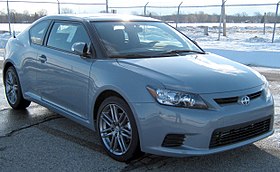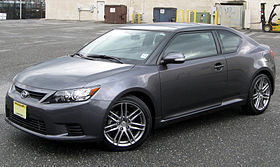Loading AI tools
Japanese compact coupe From Wikipedia, the free encyclopedia
The Scion tC is a compact car manufactured by Toyota under its Scion brand from 2004 to 2016 over two generations: ANT10 (2004–2010) and AGT20 (2011–2016). Both generations were built in Japan. The tC was introduced first in the United States for the 2005 model year and then, beginning with the second generation in the 2011 model year, in Canada as well. The tC was Scion's best-selling model, constituting almost 40% of total Scion sales.[2]
| Scion tC | |
|---|---|
 | |
| Overview | |
| Manufacturer | Toyota |
| Production | 2004–2016 |
| Model years | 2005–2016 |
| Assembly | Japan: Toyota, Aichi (Tsutsumi plant)[1] |
| Body and chassis | |
| Class | Compact car |
| Body style | 3-door hatchback coupe (liftback) |
| Layout | Front-engine, front-wheel-drive |
The name tC stands for "touring coupe." Beginning in 2011, the tC was sold as the Toyota Zelas in the Middle East, China[3] and South America,[4] a name derived from "zelante", Italian for "passionate" or "zealous."
| First generation | |
|---|---|
 | |
| Overview | |
| Model code | AT10 |
| Production | 2004–2010 |
| Model years | 2005–2010 |
| Designer | Shunsaku Kodama and So Tamiya[5] |
| Body and chassis | |
| Platform | Toyota MC platform |
| Related | Toyota Avensis (T250) |
| Powertrain | |
| Engine | 2.4 L 2AZ-FE I4 |
| Transmission | 5-speed E350 manual 4-speed U241E automatic |
| Dimensions | |
| Wheelbase | 2,700 mm (106.3 in) |
| Length | 4,420 mm (174.0 in) |
| Width | 1,755 mm (69.1 in) |
| Height | 1,415 mm (55.7 in) |
| Curb weight | 1,318 kg (2,905 lb) (manual) 1,350 kg (2,970 lb) (automatic) |
Toyota debuted the production tC at the January 2004 NAIAS with sales beginning in May 2004 as a 2005 model year. The tC was a spiritual successor to the Celica intended to appeal to the millennial market.[6] To this end, Toyota included numerous standard features, and optional features were easy to add. Standard equipment included power windows, cruise control, air conditioning, keyless entry, mirror-mounted turn signal lights, four-wheel anti-lock disc brakes, a 160-watt Pioneer sound system with CD player, 17-inch alloy wheels, and a panoramic moonroof.
The tC shares its chassis with the Avensis[7][8] and uses a MacPherson strut front and double wishbone rear suspension. It was offered at a low (base MSRP of US$17,670 for the 2009 model with manual transmission) with the pure "monospec" pricing marketing style that Toyota adopted. This generation was not sold in Canada.
A bare-bones version of the tC known as the Spec Package was offered without many of the standard accessories. The Spec Package replaced the 17-inch (430 mm) alloy wheels with 16-inch (410 mm) steel wheels and seven spoke wheel covers, and had simplified interior and exterior equipment, including a fixed rather than powered glass roof, deletion of cruise control and steering wheel audio controls, and urethane steering wheel finish instead of wrapped leather. Meant to serve as a blank slate to the tuner market, the Spec Package was offered in only four colors: Super White, Flint Mica, Black Sand Pearl and Classic Silver Metallic. MSRP was $1,400 less than the standard model. The Spec Package was discontinued for the 2009 model year.[citation needed]
The tC received a minor refresh in 2007 for the 2008 model year that included a revised grille and new, "Altezza"-styled head and taillights.
The model was Scion's best seller, reaching over 79,125 units sold in 2006,[9] but the car's sales quickly dwindled by 2010, only moving 15,204 units.[10] A 2nd generation was released for the 2011 model year.
Car and Driver praised the 2005 tC for its list of accessories but criticized its low headroom in the backseat and limited cargo room.[11]
NHTSA crash test ratings (2006)[13]
The Insurance Institute for Highway Safety (IIHS) gave the Scion tC an "Acceptable" overall score in both the frontal offset and side impact crash tests.[14][15]
All Scion tCs come standard with 4-wheel disc brakes with anti-lock brakes. For 2008 models, front seat-mounted side torso airbags, front and rear side curtain airbags, and a driver's knee airbag became standard. Front passenger classification was also added, allowing dual stage control of airbag release dependent upon the weight of the passenger.[16] Vehicle Stability Control was not originally offered until 2011 when Toyota began rolling out Electronic Stability Control (ESC) and Vehicle Stability Control (VSC)[17] in all their vehicle brands, including Scion, sold in North America.
| Second generation | |
|---|---|
 Front view (pre-facelift) | |
| Overview | |
| Model code | AT20 |
| Also called | Toyota Zelas (Central America, China, Middle East, Africa, South America) |
| Production | 2010 – August 2016[2] |
| Model years | 2011–2016 |
| Designer | Bob Mochizuki[18] |
| Body and chassis | |
| Platform | Toyota New MC platform |
| Related | Toyota Avensis (T270) |
| Powertrain | |
| Engine | 2.5 L 2AR-FE I4 |
| Transmission | 6-speed EB60 manual 6-speed U760E automatic |
| Dimensions | |
| Wheelbase | 2,700 mm (106.3 in) |
| Length | 4,420 mm (174.0 in) |
| Width | 1,796 mm (70.7 in) |
| Height | 1,415 mm (55.7 in) |
| Curb weight | 1,402 kg (3,090 lb) (manual) 1,433 kg (3,160 lb) (automatic) |

The replacement model debuted at the April 2010 New York Auto Show, and appeared in U.S. dealerships in October 2010. It received a performance bump; with the new engine being carried over from the Toyota Camry being a 2.5 liter I4 2AR-FE engine producing 180 hp (130 kW) and 174 lb⋅ft (236 N⋅m).[19] Like the first generation, the chassis remained a variant of the Toyota Avensis, the model using the third generation chassis. Visually, the second generation is a toned-down variant of the Scion Fuse concept, featuring a similar rear quarter-panel window line to the concept but with xB-styled blacked-out A-pillars. The headlights, taillights and grille received a makeover to make the car seem more muscular and angular.[20] It continued to receive very high safety marks, an all-glass roof, roomy interior, and a hatchback design. Other changes included a wider track, standard 18-inch (460 mm) wheels, larger brake discs, a more powerful engine, a six-speed transmission, and a performance-tuned electric power steering system.[21] The Scion tC now comes standard with Vehicle Stability Control. A TRD Supercharger was originally offered for the car as well as a special body kit by FiveAxis but both have since been discontinued. The tC remained popular in the tuner market, with many aftermarket performance upgrades still being available.[22]

At the 2010 Abu Dhabi Motor Show, the Scion tC was introduced under the Toyota Zelas nameplate. It later went on sale in the Middle East, with an aggressive body kit not featured on the Scion tC.[23]

Initial sales of the second generation tC fell short of expectations, and to coincide with the launch of the Scion FR-S, the tC received a facelift for the 2014 model year. Inspired by the design of the FR-S, the 2014 tC received updated headlamps, grille, LED taillights, 18-inch alloy rims, body kit, a sport-tuned suspension, reworked faster shifting transmission, sport-tuned shocks, and a new touch screen audio system standard.[24] For the first model year, Scion offered a Series 10 anniversary edition of the ten-year anniversary of the brand, limited to 3500 units. It included a new silver color, silver seat belts, a solar-powered illuminated shift knob, an LED Scion locator badge that lights up when the car is unlocked and a sequentially numbered interior badge.[25] For the 2016 model year, the tC received some minor changes, such as a standard rear windshield wiper, new silver interior door handles, center console tray cover, and a leather-wrapped shift knob, the latter of which was formerly an optional upgrade.[26]
The tC ended production in August 2016 after a final release edition as part of the phasing out of Scion brand.[2] At 29, the tC sports coupe had the lowest-average age buyer in the industry according to Toyota.[2]
| Model | Engine | Power@rpm | Torque@rpm | Transmission | 0-60 mph (0-97 km/h) | 1/4 mile | EPA fuel economy ratings | Weight | Fuel tank | Tire size |
|---|---|---|---|---|---|---|---|---|---|---|
| Scion tC[27] | 2.5 L 2AR-FE I4 (gasoline) | 180 hp (134 kW) @ 6000 rpm | 173 lb⋅ft (235 N⋅m) @ 4100 rpm | 6-speed manual transmission | 6.5s[28] | 15.1s @ 92.4 mph[28] | 23 mpg‑US (10 L/100 km; 28 mpg‑imp) city / 31 mpg‑US (7.6 L/100 km; 37 mpg‑imp) hwy | 3,060 lb (1,388 kg) -3,093 lb (1,403 kg) | 14.5 US gal (55 L; 12 imp gal) | 225/45R18 |
| 6-speed automatic transmission with manual shift mode | 7.4s[29] | 15.8s @ 88 mph[29] | 3,102 lb (1,407 kg) - 3,160 lb (1,433 kg) | |||||||
| Toyota Zelas[30] | 178 hp (133 kW) @ 6000 rpm | 172 lb⋅ft (233 N⋅m) @ 4100 rpm | 3,086 lb (1,400 kg) -3,142 lb (1,425 kg) | 215/50R17 |
NHTSA crash test ratings (2011)[31]
| Moderate overlap frontal offset | Good |
| Small overlap frontal offset | Acceptable[33] |
| Side impact | Good |
| Roof strength | Good |
Similar to many other models of Toyota/Lexus/Scion, there are many upgrades available through the in house tuning shop Toyota Racing Development (TRD). Currently TRD produces performance parts such as lowering springs and racing struts, full coilover suspension systems, performance brake kits, rear sway bars, front strut tower bars, limited-slip differentials, upgraded clutches, axle-back exhausts and cold-air intakes for the Scion tC. Other cosmetic accessories such as TRD branded valve covers and oil caps are also offered.
TRD also offered a supercharger which is a rebadged Vortech supercharger that is capable of putting out 20 psi (1.4 bar), although when installed by a dealership and under warranty it is set at 6 psi (0.4 bar). Starting in 2008, Scion began making the supercharger with tamper-proof pulleys. As of mid-2009, TRD discontinued production of superchargers for the Scion tC.[34]


Scion used a simplified "pure price" sales model that eschewed traditional factory options in favor of fixed base-vehicle pricing and buyer customization via dealer-installed accessories;[35] hence, the tC was offered in a single standard trim, with exterior colors and the choice of transmission typically being the only factory options. However, some limited-production special editions with added factory equipment and exclusive colors were offered. Beginning in late spring 2004, Scion launched the Release Series (RS) line, limited quantities of their current vehicles pre-packaged with individual numbered badging, exclusive accessories, and other special features. Their exterior colors were bright hues (i.e. orange, yellow, red, blue, green).
2005
2006
2007
2008
2009
2010
2012
2013
2014
2015
2016
The tC immediately became Scion's most popular model, representing almost half of the brand's sales in its peak years from 2005 to 2007, before being eclipsed by the redesigned xB in 2008.[2] On release of the second-generation model, Scion hoped to sell 40,000–60,000 units annually once the economy recovered,[46] but actual sales fell well short of this figure; analysts believe that sales were cannibalized by the similar FR-S.[47] Despite the decline, the tC reclaimed and held its sales lead in the Scion lineup in 2011; it was ultimately the all-time best-selling Scion, constituting almost 40% of total Scion sales from 2004 through 2015, the brand's last full year before being amalgamated into Toyota.[2]

Seamless Wikipedia browsing. On steroids.
Every time you click a link to Wikipedia, Wiktionary or Wikiquote in your browser's search results, it will show the modern Wikiwand interface.
Wikiwand extension is a five stars, simple, with minimum permission required to keep your browsing private, safe and transparent.